The issue of code-compliant security has been one of my most important areas of focus for more than a decade. Building occupants’ feelings of insecurity may lead to the use of security measures that can negatively impact egress, fire protection, and accessibility. The detailed guidelines below are intended to be used as a resource when evaluating security options, to ensure that the applicable safety requirements are met. Feel free to share!
There is a less technical version of this information available here and an infographic here.
~~~
Security and Safety of Door Openings: 7 Steps to Code Compliance
When evaluating potential security solutions for entrances, classrooms, assembly spaces, and other areas within an educational facility or for door openings in other types of buildings, it is important to consider the building codes, fire codes, and accessibility standards that apply within the jurisdiction. Model codes commonly used in the U.S. include the International Building Code (IBC), International Fire Code (IFC), and codes from the National Fire Protection Association (NFPA). Accessibility requirements are found in the ADA Standards for Accessible Design and ICC A117.1 – Accessible and Usable Buildings and Facilities. Most states adopt a combination of these codes and standards by law, often with state-specific modifications.
While the requirements of the model codes and standards may seem difficult to interpret and apply, here are 7 considerations for door openings, to help ensure the safety of all building occupants:
1) Doors must allow building occupants to exit freely, to facilitate evacuation during an emergency.
In recent years, many retrofit security products (also known as barricade devices) have entered the market, and have been considered for use in school districts, college and university campuses, and other types of buildings. While securing doors against unauthorized access is important, it’s crucial to make sure that the implemented security methods can not trap people inside of a room.
Entrapment could occur if emergency egress is required after a secondary locking device is put in place, or if an unauthorized person installs a barricade device to purposely prevent others from entering or leaving the room. In addition, many barricade devices do not comply with the model codes and accessibility standards and may violate the federal Americans With Disabilities Act (ADA).
During an unpredictable active shooter event, it’s important to have the option of evacuating the building, should that become the best course of action. The model codes require doors in a means of egress to be able to be unlatched from the inside without the use of a key, tool, special knowledge or effort. The operation of the door must be intuitive, for example, turning a lever handle or actuating the panic hardware. In most locations, the hardware must unlatch the door (all latches simultaneously) with one releasing motion.
In some jurisdictions, two non-simultaneous releasing motions are permitted to unlatch existing classroom doors in existing schools, if all other criteria are met. Under very limited circumstances, this could allow the installation of a separate deadbolt along with the latching hardware. For classrooms where there are elopement concerns about small children or students with special needs exiting unaccompanied, electrified delayed egress locks may be an option.
2) Lockable classroom doors must be able to be unlocked from the outside with a key or other approved means, to allow school staff or emergency responders to enter. This is also an important consideration for other types of buildings.
Although active shooter events in schools may seem common, they are relatively rare. Each year, the U.S. Department of Justice, Federal Bureau of Investigation (FBI) publishes a report entitled, Active Shooter Incidents in the United States, and these reports show an average of less than 4 active shooter incidents in educational facilities each year between 2010 and 2023.
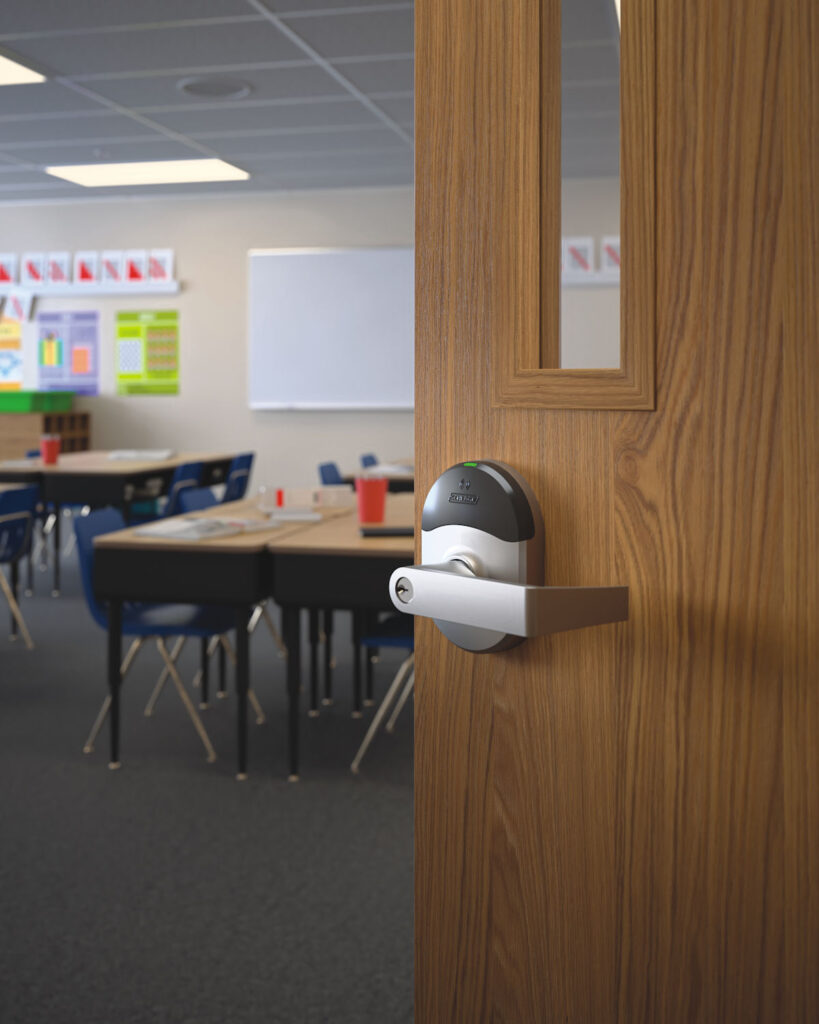
Classroom doors are required by code to allow authorized access from the outside; this is an important consideration for other types of facilities as well.
In contrast, other crimes occur frequently in educational facilities, and should be considered when evaluating security solutions. According to the National Center for Education Statistics (NCES), Report on Indicators of School Crime and Safety (2023), in 2022, U.S. students aged 12-18 experienced 568,100 criminal victimizations at school; this includes theft and violet victimization (rape, sexual assault, robbery, aggravated assault, and simple assault).
In case an unauthorized person secures a classroom or other space by locking the door, current codes require an authorized person to be able to unlock the door from the outside with a key or other approved means. During an emergency or even a fight or other disturbance, immediate access to the room is crucial. Some security devices may block access and egress and would not comply with the model code requirements.
Although a means of authorized access with a key, credential, or other approved means is specifically required by code for doors within educational occupancies, this is an important consideration for other types of facilities as well. In an office building, health care facility, store, really any type of building, a space that is able to be secured should allow access for emergency responders or other authorized people. A lack of access can lead to delays in entering the room to aid the occupants inside.
Locksets that are tested and certified for operation and durability are readily available, and may be installed with optional locked/unlocked indicators to clearly display the status of the lockset. Locks have provided a sufficient level of security during past school shootings, and a change that has been approved for the 2027 IBC requires doors in schools to be lockable from inside of the room without impeding egress. The Final Report of the Sandy Hook Advisory Commission states: “The testimony and other evidence presented to the Commission reveals that there has never been an event in which an active shooter breached a locked classroom door.”
3) Door hardware must be operable by everyone, including small children and people with disabilities.
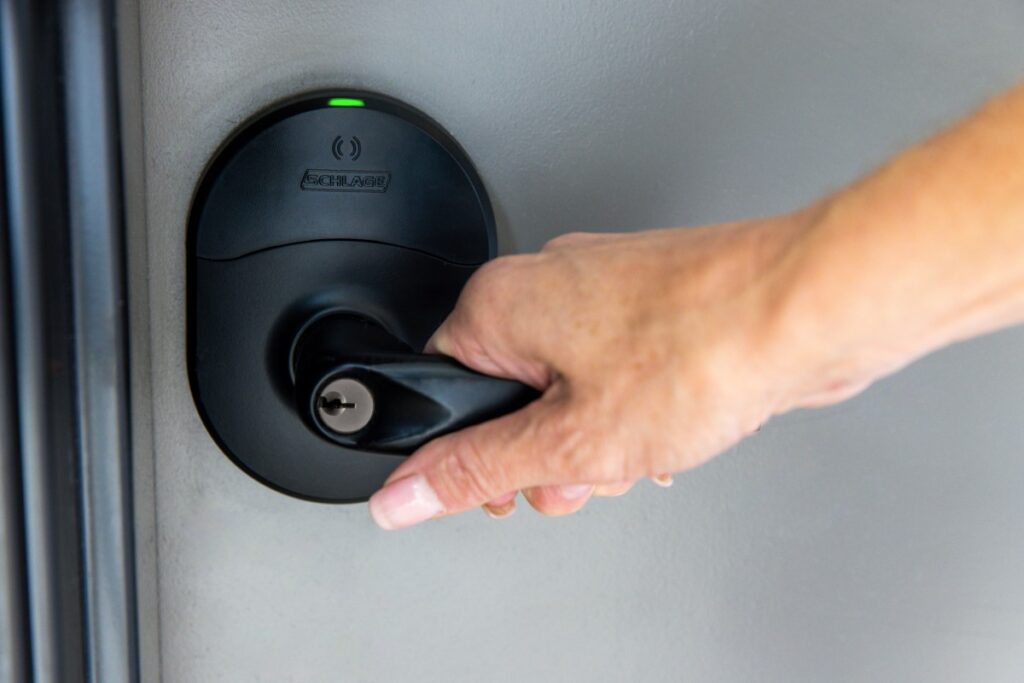
Security hardware must meet the requirements for egress and accessibility, which are outlined in the codes and standards.
To ensure that door hardware can be operated by all building occupants, the model codes and accessibility standards require hardware that is operable with one hand, and with no tight grasping, pinching, or twisting of the wrist. Releasing hardware such as lever handles and panic hardware must be mounted between 34 inches and 48 inches above the floor, or as further limited by state requirements. Barricade devices mounted near the top or bottom of the door do not comply with the mounting height limitations.
The standards limit the operable force of the hardware; the allowable force varies depending on which standard must be met. The ADA Standards for Accessible Design require hardware to be operable with no more than 5 pounds of force. The model codes and ICC A117.1 limit operable hardware to 15 pounds of pushing/pulling motion, or 28 inch-pounds of rotational motion. The best approach is to use hardware that meets the requirements of both standards.
There is currently no official certification available to verify that a security product complies with the ADA standards or other accessibility requirements. If this compliance is noted in a manufacturer’s product data, it’s worth doing some more research to see what this statement is based on.
4) Doors serving assembly spaces typically require panic hardware, which allows large groups of people to exit quickly.
Areas within a building that are used for gatherings of large groups of people are known as assembly spaces. In a school, these may include the gymnasium, auditorium, library, cafeteria, and similar areas. When a door serves an assembly space or educational occupancy with an occupant load of more than 50 people, the I-Codes typically require the door to be equipped with panic hardware or fire exit hardware. The NFPA codes also require panic hardware for doors serving these spaces, but this requirement applies when the occupant load is 100 people or more. These requirements apply to doors with a lock or latch; non-latching push/pull hardware is also acceptable if the door is not required to be fire rated. Note that there is a recent code change that addresses security hardware on exterior spaces, like enclosed courtyards.
Doors with panic hardware must not have additional mechanical locking or latching hardware, so building occupants can exit by simply pushing the touchpad or crossbar. Adding a barricade device to a door that is required to have panic hardware is a model code violation that could impede egress, and modifying panic hardware will likely void the product listing.
As with locksets on classroom doors, it is important to be able to lock doors with panic hardware from the inside during a lockdown, without affecting egress. There is panic hardware available with this capability, and a locked/unlocked indicator will help to display the secure status of the door.
5) Glazing in doors or adjacent to door hardware should be resistant to forced entry, to delay unauthorized access.
In many school districts, vision lights or sidelights are required in classroom doors by the Board of Education Standards, for visual supervision of the space. Note that the accessibility standards require the bottom of at least one of these vision lights to be no more than 43 inches above the floor. Main entrance doors and secondary entrance doors to schools also typically have glazing in and/or around the door. If the impact-resistance of the glazing in these doors is not addressed, the glass may be a weak link in the security chain.
For school entrances, the Sandy Hook Advisory Commission and the Partner Alliance for Safer Schools (PASS) recommend secure vestibules with forced entry resistant doors and glazing. The Final Report of the Federal Commission on School Safety also references forced entry resistant doors, windows, framing, and anchoring. In addition to the recommendations for forced entry resistance, these organizations as well as the Marjory Stoneman Douglas High School Public Safety Commission recommend that classrooms with windows should have the ability to conceal or obstruct window views, so an assailant can’t see in.
6) Doors must be openable with a limited amount of force, and automatic operators may be required in some locations.
The codes and standards limit the amount of opening force to be used to open a door manually. In most jurisdictions, the opening force limit for interior, non-fire-rated swinging doors is 5 pounds. For exterior doors and fire doors, the model codes allow a maximum of 30 pounds to set the door in motion and 15 pounds to open the door fully.
To help ensure that a person using a wheelchair can open the door manually, clear floor space known as “maneuvering clearance” is required on each side of the door opening. In addition, the bottom rail of the door must be at least 10 inches high (measured from the floor), and no protruding hardware may be installed in this area. Surface-mounted security devices installed at the bottom of the door will likely conflict with these requirements.
When a door can not meet the accessibility requirements for a manually operated door, an automatic operator may help to bring the door into compliance, and automatic doors are now required by code in some locations. Beginning with the 2021 edition of the IBC, the code mandates at least one power-operated door or one set of power-operated doors (exterior and vestibule), at each accessible public entrance for buildings meeting certain criteria.
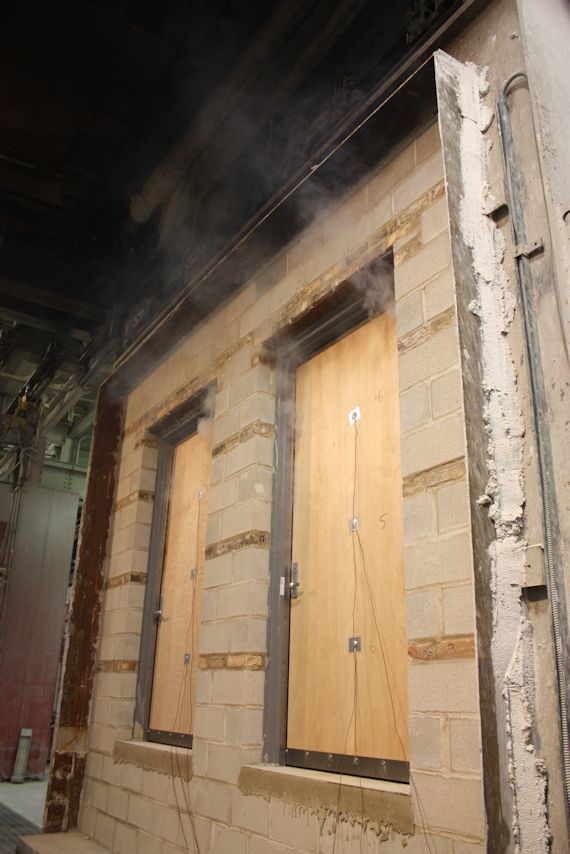
Components installed as part of a fire door assembly are tested and listed to ensure that they will not negatively impact the performance of the assembly during a fire.
7) Fire door assemblies, which help to deter the spread of smoke and flames, are subject to specific requirements to ensure their performance during a fire.
There are multiple hazards to be considered when addressing security and safety in educational buildings and other occupancy types, and fire safety is one of the concerns. Based on statistics from the NFPA, we can conservatively estimate that between 2010 and 2020, approximately 4,800 fires occurred in schools and other educational facilities each year. In comparison with the FBI average of less than 4 active shooter events in educational buildings per year, the frequency of fire emergencies illustrates the need to find a balance rather than focusing only on security.
Fire door assemblies play an important role in the passive fire protection system of a building, deterring the spread of smoke and flames and protecting the means of egress during a fire. These doors are strictly regulated by the codes and standards, to help ensure that they perform as designed and tested during a fire. Acceptable field alterations are limited, and each component must be listed for use as part of a fire door assembly. Installing non-listed products or modifying fire doors and frames in the field may void the rating and affect the performance of the assembly.
Fire doors are also known as “opening protectives” because they protect openings in fire-resistant walls. To provide this protection, fire doors must be closed and latched when a fire occurs. Fire doors must not be propped open with door wedges, mechanical hold-opens, or other devices – there are electrified products that may be installed for this purpose. Magnets or other means of preventing a fire door from latching are prohibited – again, there are electrified options for achieving convenience, security, and safety.
It’s very important to ensure that life safety is not compromised by security measures. During an active shooter incident or other emergency, free egress and fire protection are crucial. Compliance with the accessibility requirements and the ADA is mandatory at all times – under normal operation and during an emergency.
When considering security methods, the codes adopted in the facility’s jurisdiction should be consulted for specific requirements, and the Authority Having Jurisdiction (AHJ) has the final say. The current code requirements are based on more than 100 years of lessons learned and exist for the safety of building occupants.
Lock the door – without compromising life safety.
You need to login or register to bookmark/favorite this content.


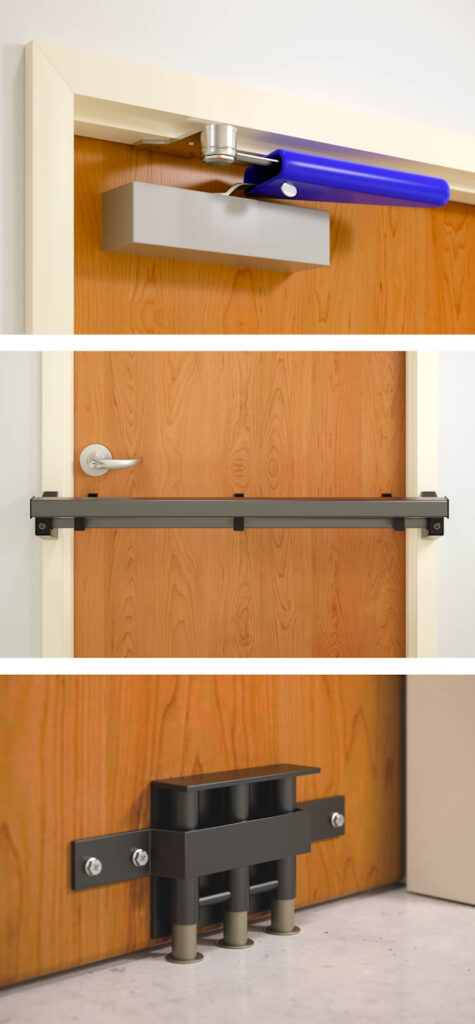
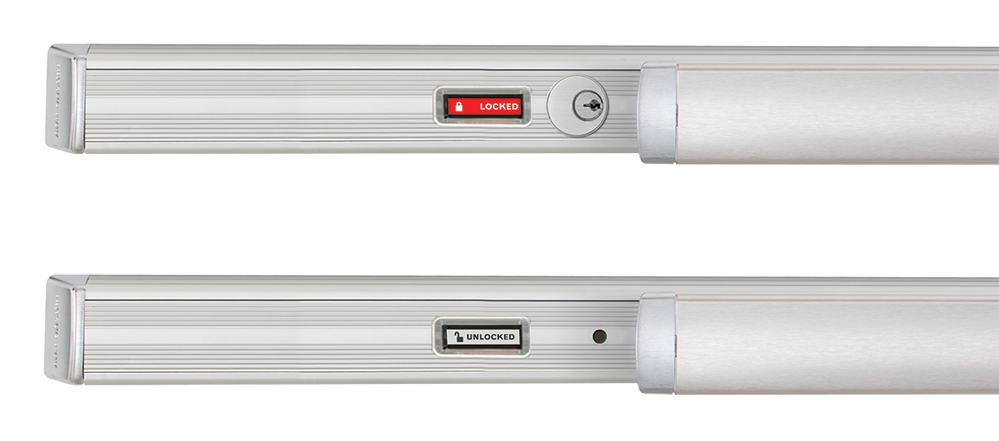


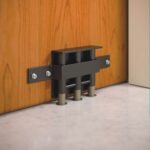






Leave A Comment